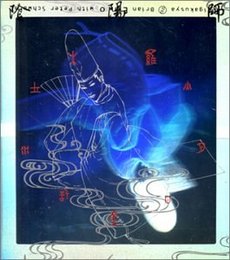Eno goes to Japan and uses lots of Yamaha gear...
burt_whistle | Cambridge, Cambs. United Kingdom | 01/19/2001
(4 out of 5 stars)
"Although two discs, Eno and Schwalm contribute to just one, and their music lasts about thirty minutes. For the hardened Eno fan this might seem something of a rip off. However taken as a whole, the Japanese music on disc one is a real eye opener, and the counterpoint of Western electronic music against music utilising traditional Japanese musical materials is, I think, a satisfying one. Not being cogniscent of Japanese music, I can only really talk about the Eno/Schwalm. Not only that, all the sleevenotes about the Japanese music are in, well, Japanese... The music itself seems to be an extension of the Kiasma Museum installation "Kite Stories", but richer, perhaps, and with much FM synthesis to the fore. "Faraway Suns" carries on where "Saint Tom" left off, "Little Lights" sounds like a more electronic "On Land", while "Star Gods" sounds like it would be at home in a traditional electro-acoustic music concert. If this is what he's getting up to with Schwalm, their forthcoming release should be very interesting indeed. The cover art, by the way, is fabulous."
Take it as the whole it was meant to be
Charles A. Miller | Baltimore, Maryland U.S.A. | 03/01/2004
(5 out of 5 stars)
"Interestingly, there are critics who are not very happy with the amount of time that Brian Eno and Peter Schwalm contributed to this release. The misunderstanding regarding the content of this 2-CD set is understandable however. This title does come up when a search for CDs by Brian Eno or Peter Schwalm is performed, so therefore, folks might think that they are getting a Brian Eno and/or Peter Schwalm CD.
But that is not the case here. What you are getting is traditional Japanese Heian music, which is what comprises the 74-minute first disc. The Heian period in Japanese history was from 794 to 1192 A.D. This is indeed an eye-opener for those who are musically adventurous (and I would think such would be the case for any fan of Brian Eno's music).
That leaves the 28-minute second disc. According to the liner notes, Brian Eno states his intention to create an alternate musical universe on disc two... one that is not necessarily Japanese in sound, but one that could have conceivably coexisted with Heian music. In that regard, and taken in that context, Mr. Eno has succeeded admirably well. In fact, I cannot imagine listening to disc two without having listened to disc one first. Together, they make an integral package and should be regarded as such.
That said, why is disc two only 28 minutes long? Perhaps it was all that was required. Why is it so expensive? Because it is a Japanese import, and like other Japanese imports, the price tag is not unusual.
Is this a good "introduction" to Brian Eno's music? Considering the price tag and length of the Eno's contribution, the answer is no. On the other hand, this release is not just for "completists" either. Certainly, listening to both discs with an open mind will yield a mind-opening experience."
Sometimes you miss.
Elessar Tetramariner | Ann Arbor, MI USA | 06/02/2000
(2 out of 5 stars)
"As a fan of almost all the genres and sub-genres of music Brian Eno has had his hand in since 1972, I regretfully say that, other than for it's collectibility, this pricey set should not be sought by any but the most determined collectors. The packaging is 75% Japanese in both presentation and content, so it's not easy for foreigners to assimilate. Too, Eno, contributes musically to only 1 of the 2 cds, so it's "half an Eno at thrice the price of one". Perhaps he has achieved by issuing this a reduction on the demands for his attention and time. With a few more like this and some of it's Eno-involved predecessors since 1994, the wolves may stop circling his door for a while and he can breathe again and create something that has had time to gestate and mature before release."


 Track Listings (6) - Disc #1
Track Listings (6) - Disc #1